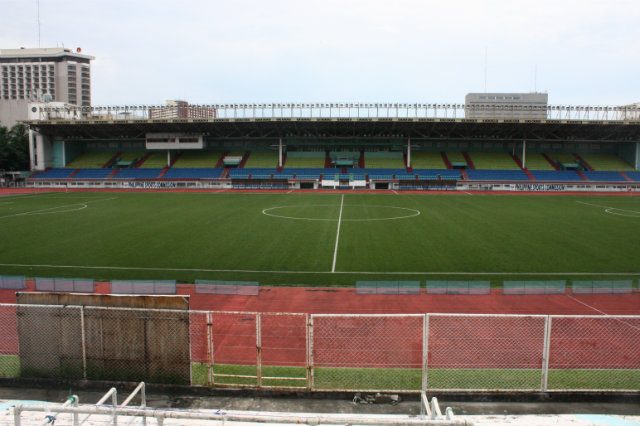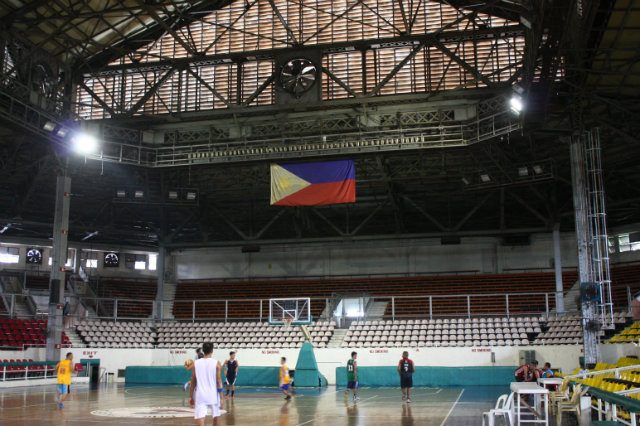SUMMARY
This is AI generated summarization, which may have errors. For context, always refer to the full article.

MANILA, Philippines – Rizal Memorial Coliseum is located at Vito Cruz St. at the heart of the city of Manila. It is a stone’s throw away from Manila Bay, which in 1934, was an ideal location for sports venues. This was where the people of Manila and nearby cities would regularly converge on weekends. The building stood magnificently overlooking the bay area.
It was originally built to host the Far Eastern Championship Games, the precursor to the Asian games. Since then it has been the venue of many sporting events such as the 1954 Asian Games as well as the South East Asian Games in 1981, 1991 and 2005. Moreover, the National Collegiate Athletic Association (NCAA) and the Universities Athletic Association of the Philippines (UAAP) used to hold their games at the coliseum.
The Manila Industrial and Commercial Athletic Association (MICAA), the first major semi-pro basketball league of the country was played there and so were a lot of games of the Philippine Basketball Association (PBA).
Not only did ”Rizal” house these tournaments, it was witness also to the victories and defeats of many of Pinoy greats. Felicisimo Ampon wowed the crowd at the tennis courts. Lydia de Vega and Isidro del Prado spent countless hours around the track oval. Rodolfo Lugay and Boy Codinera were hitting homeruns against their foreign competitors at the baseball diamond.
Akiko Thompson and Ryan Papa swam numerous laps in the complex’s swimming pool. Caloy Loyzaga, Lauro Mumar, Antonio Genato and the rest of the 1954 basketball team won the gold at the Asian games at Rizal’s basketball court. Local basketball heroes like Robert Jaworski, Rudy Soriano and Big Boy Reynoso will surely have many tales to tell about this place. Not to mention the hundred other athletes who have called the coliseum their home.
Personal attachment
I spent a good part of my childhood at Rizal Coliseum. I used to spend Sundays at the baseball diamond enjoying local ballplayers dominating against visiting American and Japanese teams. The Manila Bay Baseball League (MBBL) was so popular back then that we had to buy tickets from scalpers. I soon after took the game up and joined other boys at training camps at the coliseum set up by the very athletes whom I would come to watch.

I also recall a full summer spent at the championship tennis courts. These courts were converted to what is now known as Ninoy Aquino Stadium. Because we could not afford to take regular tennis lessons, I had to work as a ball boy during peak hours in exchange for the use of the court during non-peak times. I would be brought there early in the morning and picked up before sunset. In between games and practices, I would walk around with other boys, most of whom were sons of athletes and coaches, to watch other sports in other parts of the venue.
I spent my grade school years at De La Salle which is located right beside Rizal. The Olympic pool is visible from the 3rd floor of our main building so my classmates and I were able to watch several thrilling races from our classroom. In fact, little do people know, there is a gate that connects Rizal Memorial to my school. It allowed me to walk within this sporting memorial any time of day and get to watch the athletes either train or compete.
Decaying edifice
Today, the Rizal Memorial Coliseum seems to be a forgotten reminder how great sport was in the country. Its aging walls and crumbling structure some say reflect the current state of Philippine sports. It is a reminder of a glorious age that once was and a future that may never be.
There are currently no major sporting events both local and international being held at the complex. The PBA moved to other locations a long time ago. The NCAA and UAAP games are being played in more modern and more accessible basketball venues. Baseball games are still played but the diamond needs a major upgrade. Only the football pitch has been refurbished and this is due to the sudden surge in popularity of the sport due to the success of the Azkals.
Over the past several years there have been talks about what to do with the property and the building. The Philippine Sports Commission (PSC), the government office tasked to manage the place, is openly considering to sell the complex. Several years ago, the topic was raised when Congressman Yeng Guiao proposed a sports facility to be built in the vicinity of Clark Field but said funds from the sale of the current structure are needed to jumpstart the new project.
Several proponents raised the concern that the land belonged to the City of Manila and that selling the complex would be a gain to the city. Mall and condominium developers have apparently signaled their interest.
Mixed reactions, various suggestions
Mr. Ed Picson, executive director of the Amateur Boxing Association of the Philippines (ABAP) has deep sentiments about the place. The boxing National Sports Association (NSA) continues to house and train their boxers there. With the funding from the PSC and the MVP Group of Companies, ABAP has opted to keep their base within the walls. He says that despite what other people say about how old the building is and its current surroundings, the history of the complex provides an intangible value to current athletes.
Mr. Picson regards it as testimonial to Philippine sports and certainly it speaks of the past. He regards it as an important ingredient in shaping the future.
Part of the argument with transfering its facilities is that it is located in the middle of an overpopulated city with a huge pollution problem. Mr. Picson says that instead of destroying the facility, government should solve the pollution.

Dina Bernardo, former Captain of the National Women’s Dragonboat Team and executive director of the PSC in 2010-2011, offers a different view. Having the interests of all national teams in mind, Dina believes that it is time to build a new facility elsewhere. She suggests to allow the NSAs to determine their particular needs and identify the specific location by which they can truly develop the athletes. Although she is open to the idea of selling Rizal Memorial, she offers her own vision. “I hope that the plan is to keep the location as a living memorial about local sports. It can be a museum, a tourist location, a memorial of sorts,” she says.
Facing reality
The Rizal Memorial Coliseum, aptly named after the country’s national hero, continues to house and support our national athletes. It is the home of our archers, runners, basketball, volleyball, baseball players. Tae Kwon Do jins train there and our contact sports athletes leave marks on the floors with their blood sweat and tears.
However, development or non-development of its surroundings has diminished its value. Everyone outside its walls seems to be oblivious of what truly goes on within. The city itself may not ever truly comprehend how priceless this edifice is.
For the sake of Philippine sports a world class training facility and program is necessary. Upgrading and restoring the Rizal Memorial Complex will be very much appreciated. The option of building this new training facility outside the memorial in another part of the country is acceptable but will bring emotional pain to many.
“Rizal” today does not just stand as a training location. Its involvement in Philippine sports history has transformed it into a symbol. A representation of the Filipinos victories and defeats in various sports disciplines. It is the badge of courage every athlete who has played there secretly carry.
As the late educator Janus A. Percoco, an advocate of promoting good history education, articulated: “…..monuments and memorials are living pieces of history, not static markers on a timeline.”
Rizal Memorial Coliseum lives. Keep it alive! – Rappler.com
Add a comment
How does this make you feel?
There are no comments yet. Add your comment to start the conversation.